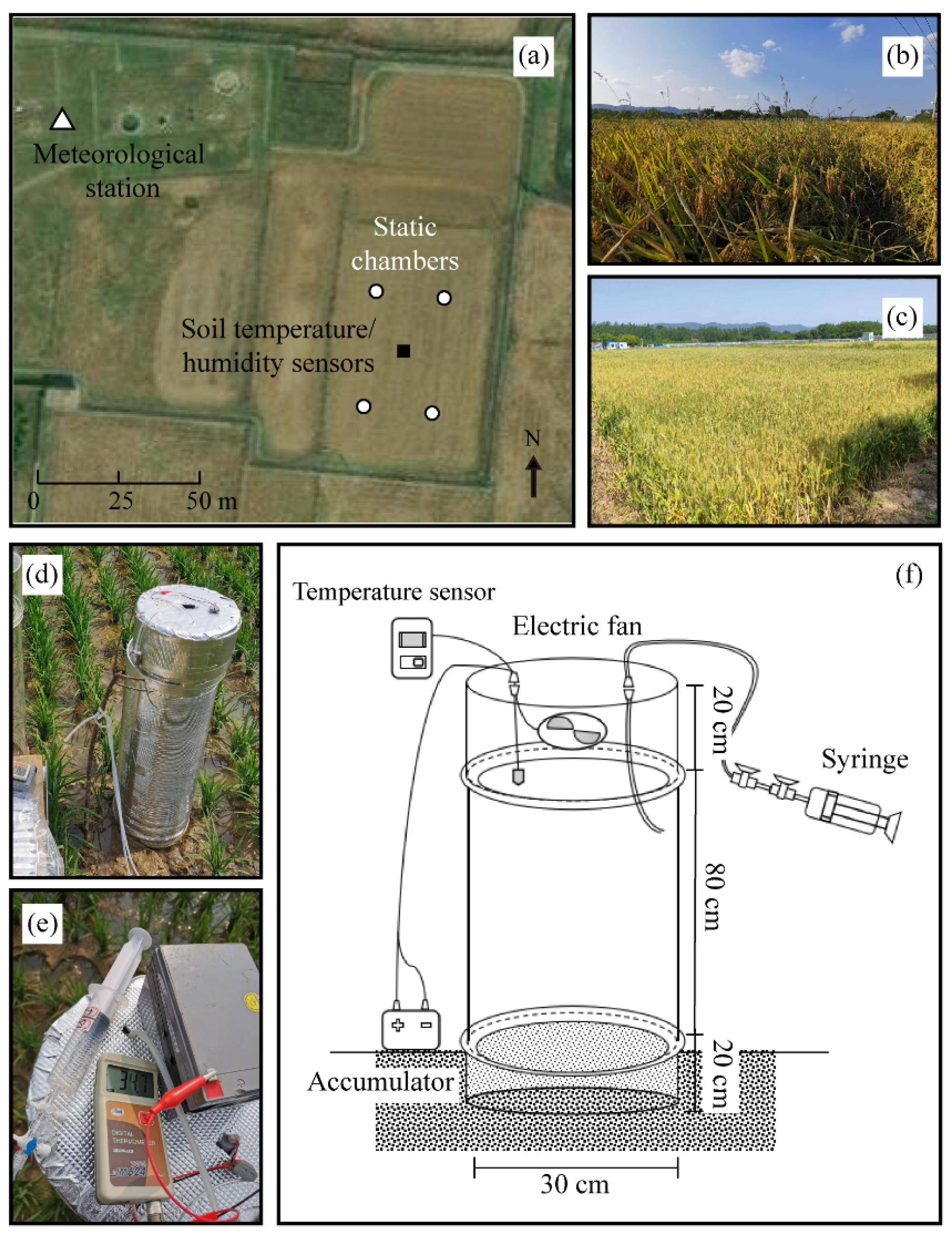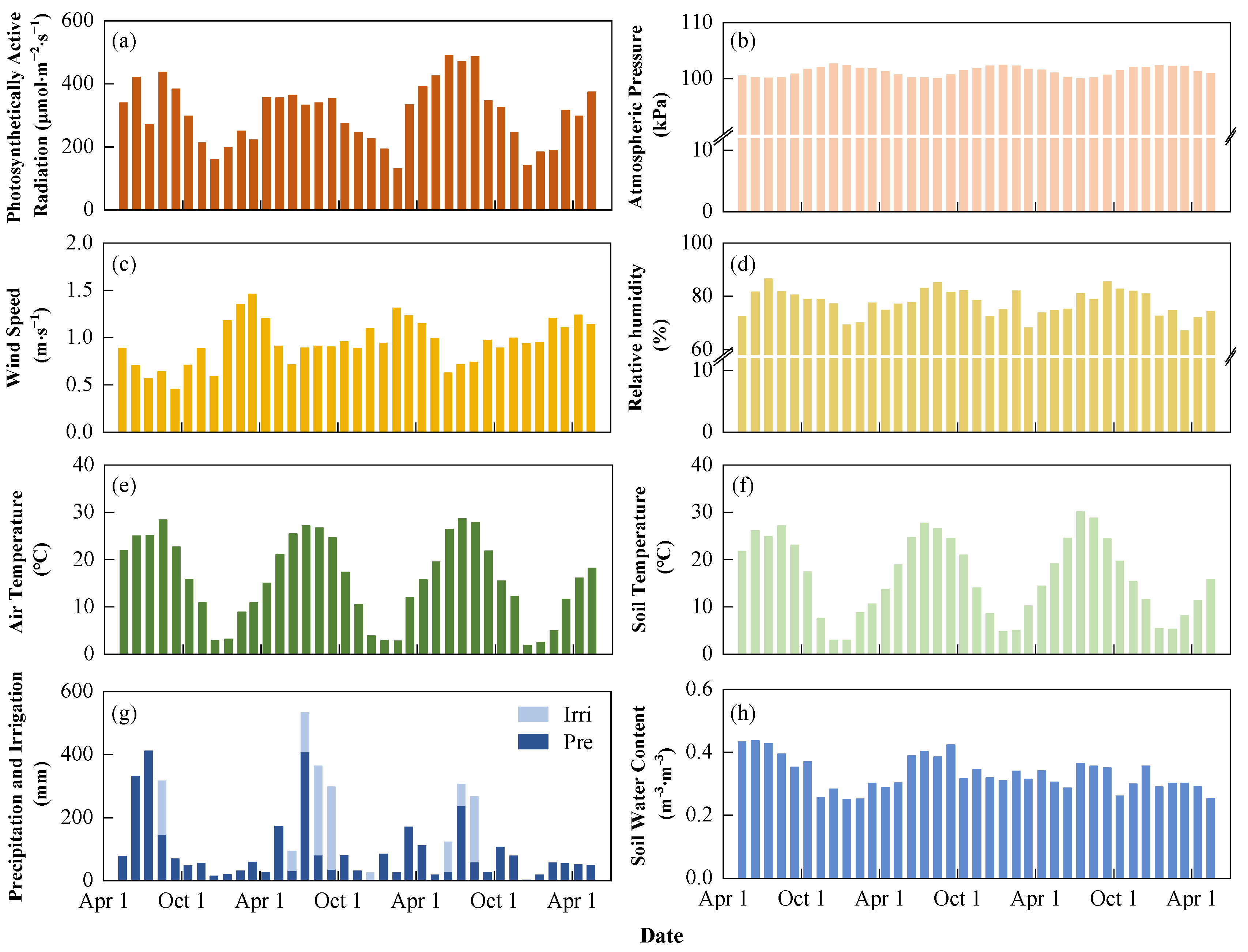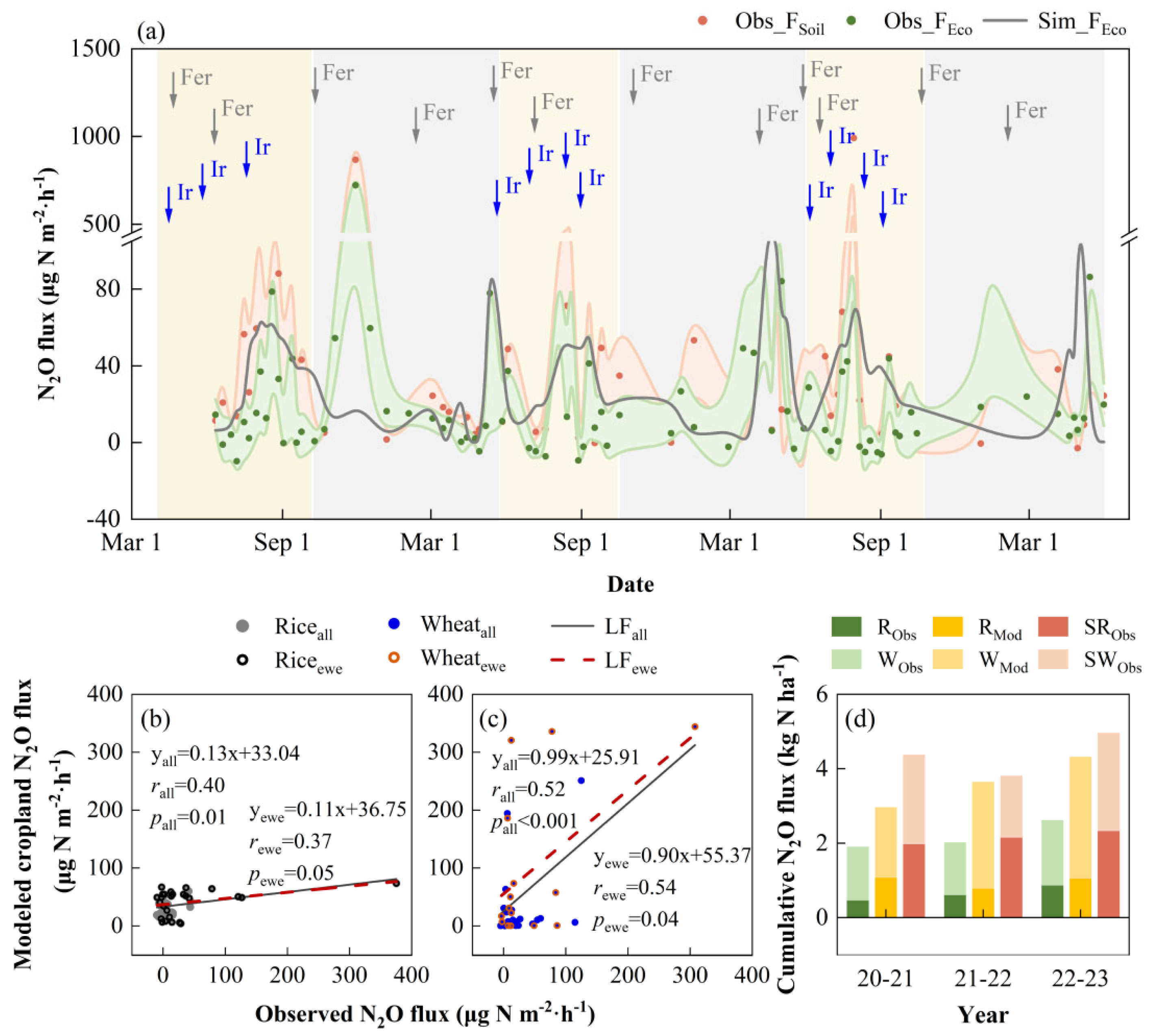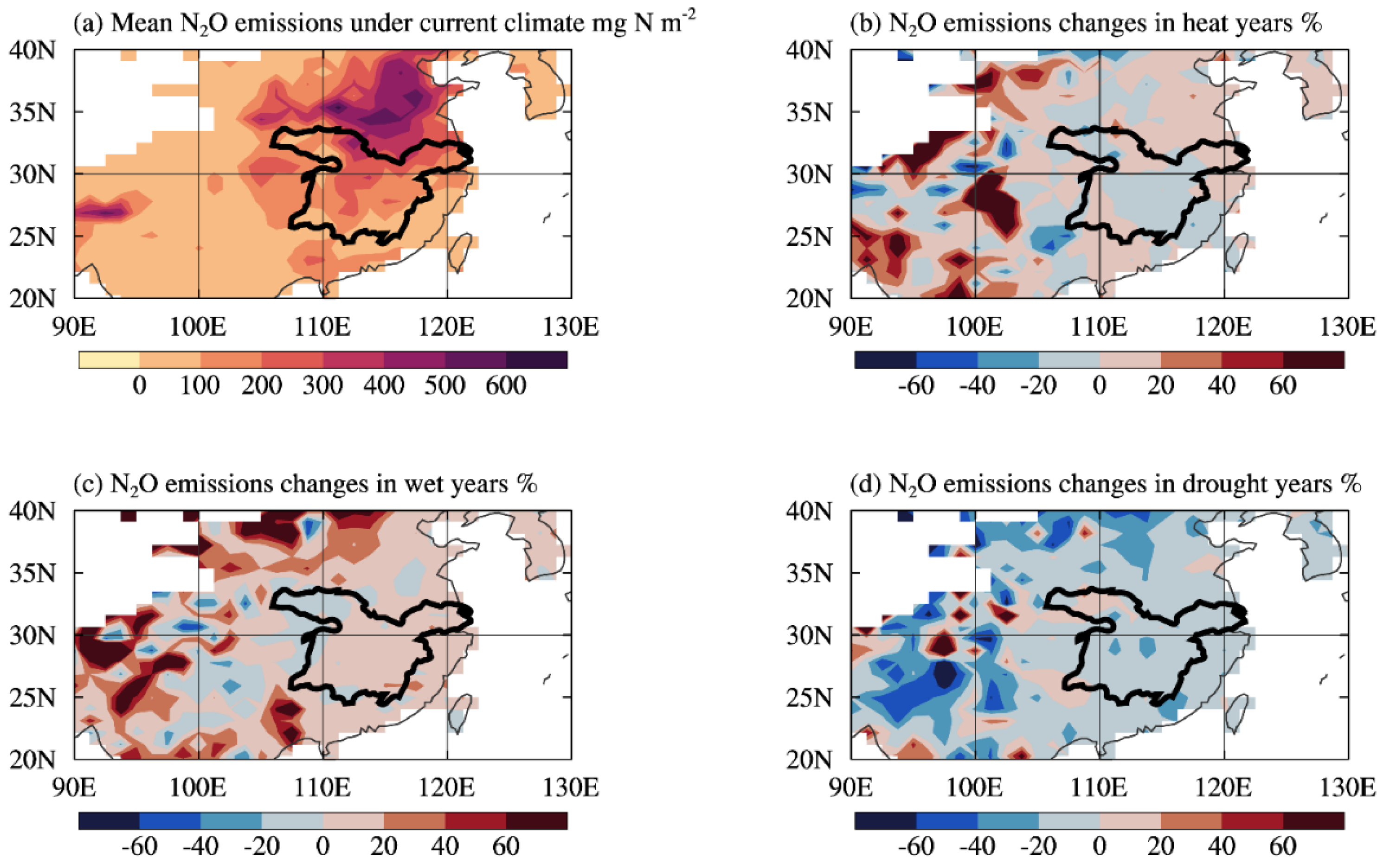Effects of Extreme Weather Events on Nitrous Oxide Emissions from Rice-Wheat Rotation Croplands
Abstract
:1. Introduction
2. Materials and Methods
2.1. Study Sites and Data
2.2. Community Land Model
3. Results and Discussion
3.1. Meteorological and Soil Variables
3.2. Observed and Modeled N2O Fluxes in Cropland
3.3. Impact of Extreme Weather Events on N2O Emissions
3.3.1. Extreme Heat Events
3.3.2. Extreme Precipitation and Drought Events
3.4. Impact of Extreme Weather Events on N2O Emissions in the MLRYR
4. Conclusions
- (a)
- The cropland with rice and winter wheat rotation exhibited a source of N2O, with annual cumulative N2O emissions ranging from 190.4 to 261.8 mg N m−2. N2O emissions from rice cropland peaked during the rice booting-filling stage, contributing 29% to the annual cumulative emissions. N2O emissions from wheat cropland reached the peak during the maturing stage, accounting for 71% of the annual cumulative emissions.
- (b)
- There was a 23% to 32% increase in observed N2O emissions from cropland ecosystems during extreme heat events which likely resulted from enhanced nitrification and denitrification processes and weakened nitrogen uptake capacity of the rice root system. N2O emissions from irrigated rice cropland during extreme precipitation events were 45% lower compared to those during extreme drought events. In the growing seasons of rain-fed wheat, extreme precipitation events increased observed N2O emissions by 36%, while extreme drought events decreased N2O emissions by 20%.
- (c)
- The simulations reproduced the seasonal dynamics of N2O fluxes from cropland ecosystems well. Regional simulations demonstrated that the annual cumulative N2O emissions from rice and wheat cropland in the MLRYR were 207.8 mg N m−2, and N2O emissions are projected to increase in the future (303.4 mg N m−2). Furthermore, future extreme heat events are expected to enhance the N2O emissions. Considering the complexity and uncertainty in the responses of N2O emissions from cropland ecosystems to extreme weather events, exceptional caution should be taken when utilizing the model to investigate the impacts of extreme events on N2O emissions from cropland ecosystems.
Supplementary Materials
Author Contributions
Funding
Data Availability Statement
Acknowledgments
Conflicts of Interest
References
- Ravishankara, A.R.; Daniel, J.S.; Portmann, R.W. Nitrous oxide: The dominant ozone-depleting substance emitted in the 21st century. Science 2009, 326, 123–125. [Google Scholar] [CrossRef] [PubMed]
- Prather, M.J.; Hsu, J.; DeLuca, N.M.; Jackman, C.H.; Oman, L.D.; Douglass, A.R.; Fleming, E.L.; Strahan, S.E.; Steenrod, S.D.; Søvde, O.A.; et al. Measuring and modeling the lifetime of nitrous oxide including its variability. J. Geophys. Res. Atmos. 2015, 120, 5693–5705. [Google Scholar] [CrossRef] [PubMed]
- Saikawa, E.; Prinn, R.G.; Dlugokencky, E.; Ishijima, K.; Dutton, G.S.; Hall, B.D.; Langenfelds, R.; Tohjima, Y.; Machida, T.; Manizza, M.; et al. Global and regional emissions estimates for N2O. Atmos. Chem. Phys. 2014, 14, 4617–4641. [Google Scholar] [CrossRef]
- Tian, H.; Xu, R.; Canadell, J.G.; Thompson, R.L.; Winiwarter, W.; Suntharalingam, P.; Davidson, E.A.; Ciais, P.; Jackson, R.B.; Janssens-Maenhout, G.; et al. A comprehensive quantification of global nitrous oxide sources and sinks. Nature 2020, 586, 248–256. [Google Scholar] [CrossRef] [PubMed]
- Dalal, R.C.; Wang, W.; Robertson, G.P.; Parton, W.J. Nitrous oxide emission from Australian agricultural lands and mitigation options: A review. Soil Res. 2003, 41, 165–195. [Google Scholar] [CrossRef]
- Gupta, D.K.; Bhatia, A.; Kumar, A.; Das, T.K.; Jain, N.; Tomer, R.; Malyan, S.K.; Fagodiya, R.K.; Dubey, R.; Pathaka, H. Mitigation of greenhouse gas emission from rice–wheat system of the Indo-Gangetic plains: Through tillage, irrigation and fertilizer management. Agric. Ecosyst. Environ. 2016, 230, 1–9. [Google Scholar] [CrossRef]
- Fagodiya, R.K.; Kumar, A.; Kumari, S.; Medhi, K.; Shabnam, A.A. Contaminants in Agriculture; Naeem, M., Ansari, A.A., Gill, S.S., Eds.; Springer: Berlin/Heidelberg, Germany, 2020. [Google Scholar]
- Kumar, A.; Medhi, K.; Kishor, R.; Mondal, F.R.; Raja, P.; Subrahmanyam, G.; Malyan, S.K.; Gupta, D.K.; Gupta, C.K.; Pathak, H. Molecular and ecological perspectives of nitrous oxide producing microbial communities in agro-ecosystems. Rev. Environ. Sci. Bio/Technol. 2020, 19, 717–750. [Google Scholar] [CrossRef]
- Signor, D.; Eduardo, C.; Cerri, P. Nitrous oxide emissions in agricultural soils: A review. Pesqui. Agropecu. Trop. 2013, 43, 322–338. [Google Scholar] [CrossRef]
- Hegerl, G.C.; Hanlon, H.; Beierkuhnlein, C. Elusive extremes. Nat. Geosci. 2011, 4, 142–143. [Google Scholar] [CrossRef]
- Song, J.; Wan, S.; Piao, S.; Knapp, A.K.; Classen, A.T.; Vicca, S.; Ciais, P.; Hovenden, M.J.; Leuzinger, S.; Beier, C.; et al. A meta-analysis of 1119 manipulative experiments on terrestrial carbon-cycling responses to global change. Nat. Ecol. Evol. 2019, 3, 1309–1320. [Google Scholar] [CrossRef]
- Sun, Q.; Zhao, Y.; Zhang, Y.; Chen, S.; Ying, Q.; Lv, Z.; Che, X.; Wang, D. Heat stress may cause a significant reduction of rice yield in China under future climate scenarios. Sci. Total Environ. 2022, 818, 151746. [Google Scholar] [CrossRef] [PubMed]
- Qu, Q.; Xu, H.; Ai, Z.; Wang, M.; Wang, G.; Liu, G.; Geissen, V.; Ritsem, C.J.; Xue, S. Impacts of extreme weather events on terrestrial carbon and nitrogen cycling: A global meta-analysis. Environ. Pollut. 2023, 319, 9. [Google Scholar] [CrossRef] [PubMed]
- Breshears, D.D.; Fontaine, J.B.; Ruthrof, K.X.; Field, J.P.; Feng, X.; Burger, J.R.; Law, D.J.; JatinKala; Hardy, G.E.S.J. Underappreciated plant vulnerabilities to heatwaves. New Phytol. 2021, 231, 32–39. [Google Scholar] [CrossRef] [PubMed]
- Rafique, R.; Kumar, S.; YiqiLuo; Xu, X.; Li, D.; Zhang, W.; Asam, Z.-u.-Z. Estimation of greenhouse gases (N2O, CH4 and CO2) fromno-till cropland under increased temperature and altered precipitation regime: A DAYCENT model approach. Glob. Planet. Chang. 2014, 118, 106–114. [Google Scholar] [CrossRef]
- Wu, D.; Dong, W.; Oenema, O.; Wang, Y.; Trebs, I.; Hu, C. N2O consumption by low-nitrogen soil and its regulation by water and oxygen. Soil Biol. Biochem. 2013, 60, 165–172. [Google Scholar] [CrossRef]
- Smith, K.A. Changing views of nitrous oxide emissions from agricultural soil: Key controlling processes and assessment at different spatial scales. Eur. J. Soil Sci. 2017, 68, 137–155. [Google Scholar] [CrossRef]
- Li, C.; Salas, W.; Zhang, R.; Krauter, C.; Rotz, A.; Mitloehner, F. Manure-DNDC: A biogeochemical process model for quantifying greenhouse gas and ammonia emissions from livestock manure systems. Nutr. Cycl. Agroecosyst. 2012, 93, 163–200. [Google Scholar] [CrossRef]
- Gabrielle, B.; Menasseri, S.; Houot, S. Analysis and Field Evaluation of the Ceres Models Water Balance Component. Soil Sci. Soc. Am. J. 1995, 59, 1403–1412. [Google Scholar] [CrossRef]
- Boas, T.; Bogena, H.; Grünwald, T.; Heinesch, B.; Ryu, D.; Schmidt, M.; Vereecken, H.; Western, A.; Hendricks Franssen, H.-J. Improving the representation of cropland sites in the Community Land Model (CLM) version 5.0. Geosci. Model Dev. 2021, 14, 573–601. [Google Scholar] [CrossRef]
- Williams, J.R.; Jones, C.A.; Kiniry, J.R.; Spanel, D.A. The EPIC Crop Growth Model. Trans. ASAE 1989, 32, 497–511. [Google Scholar] [CrossRef]
- Keating, B.A.; Carberry, P.S.; Hammer, G.L.; Probert, M.E.; Robertson, M.J.; Holzworth, D.; Huth, N.I.; Hargreaves, J.N.G.; Meinke, H.; Hochman, Z.; et al. An overview of APSIM, a model designed for farming systems simulation. Eur. J. Agron. 2003, 18, 267–288. [Google Scholar] [CrossRef]
- Levis, S.; Badger, A.; Drewniak, B.; Nevison, C.; Ren, X. CLMcrop yields and water requirements: Avoided impacts by choosing RCP 4.5 over 8.5. Clim. Chang. 2018, 146, 501–515. [Google Scholar] [CrossRef]
- Fung, K.M.; Martin, M.V.; Tai, A.P.K. Modeling the interinfluence of fertilizer-induced NH3 emission, nitrogen deposition, and aerosol radiative effects using modified CESM2. Biogeosciences 2022, 19, 1635–1655. [Google Scholar] [CrossRef]
- Yang, S.; Chen, K.; Zhu, B.; Tian, Y.; Zeng, Z.; Liu, M.; Zheng, C. How does irrigation alter the water, carbon, and nitrogen budgets in a large endorheic river basin? J. Hydrol. 2022, 613, 128317. [Google Scholar] [CrossRef]
- Martin, M.V.; Blanc-Betes, E.; Fung, K.M.; Kantzas, E.P.; Kantola, I.B.; Chiaravalloti, I.; Taylor, L.T.; Emmons, L.K.; Wieder, W.R.; Planavsky, N.J.; et al. Improving nitrogen cycling in a land surface model (CLM5) to quantify soil N2O, NO and NH3 emissions from enhanced rock weathering with croplands. Geosci. Model Dev. Discuss. 2023, 16, 5783–5801. [Google Scholar] [CrossRef]
- Lin, S.; Iqbal, J.; Hu, R.; Feng, M. N2O emissions from different land uses in mid-subtropical China. Agric. Ecosyst. Environ. 2010, 136, 40–48. [Google Scholar] [CrossRef]
- Hutchinson, G.L.; Livingston, G.P. Use of chamber systems to measure trace gas fluxes. Agric. Ecosyst. Eff. Trace Gases Glob. Clim. Chang. 1993, 55, 63–78. [Google Scholar] [CrossRef]
- Bavin, T.K.; Griffis, T.J.; Baker, J.M.; Venterea, R.T. Impact of reduced tillage and cover cropping on the greenhouse gas budget of a maize/soybean rotation ecosystem. Agric. Ecosyst. Environ. 2009, 134, 234–242. [Google Scholar] [CrossRef]
- Danabasoglu, G.; Lamarque, J.F.; Bacmeister, J.; Bailey, D.A.; DuVivier, A.K.; Edwards, J.; Emmons, L.K.; Fasullo, J.; Garcia, R.; Gettelman, A.; et al. The Community Earth System Model Version 2 (CESM2). J. Adv. Model. Earth Syst. 2020, 12, e2019MS001916. [Google Scholar] [CrossRef]
- Lawrence, D.M.; Fisher, R.A.; Koven, C.D.; Oleson, K.W.; Swenson, S.C.; Bonan, G.; Collier, N.; Ghimire, B.; Kampenhout, L.; Kennedy, D.; et al. The Community Land Model Version 5: Description of New Features, Benchmarking, and Impact of Forcing Uncertainty. J. Adv. Model. Earth Syst. 2019, 11, 4245–4287. [Google Scholar] [CrossRef]
- Fu, C.; Wang, G.; Bible, K.; Goulden, M.L.; Saleska, S.R.; Scott, R.L.; Cardon, Z.G. Hydraulic redistribution affects modeled carbon cycling via soil microbial activity and suppressed fire. Glob. Chang. Biol. 2018, 24, 3472–3485. [Google Scholar] [CrossRef] [PubMed]
- Koven, C.D.; Riley, W.J.; Subin, Z.M.; Tang, J.Y.; Torn, M.S.; Collins, W.D.; Bonan, G.B.; Lawrence, D.M.; Swenson, S.C. The effect of vertically resolved soil biogeochemistry and alternate soil C and N models on C dynamics of CLM4. Biogeosciences 2013, 10, 7109–7131. [Google Scholar] [CrossRef]
- Fu, C.; Lee, X.; Griffis, T.J.; Wang, G.; Wei, Z. Influences of Root Hydraulic Redistribution on N2O Emissions at AmeriFlux Sites. Geophys. Res. Lett. 2018, 45, 5135–5143. [Google Scholar] [CrossRef]
- Fu, C.; Wang, G.; Yang, Y.; Wu, H.; Wu, H.; Zhang, H.; Xia, Y. Temperature Thresholds for Carbon Flux Variation and Warming-Induced Changes. J. Geophys. Res. Atmos. 2023, 128, e2023JD039747. [Google Scholar] [CrossRef]
- Hurrell, J.W.; Holland, M.M.; Gent, P.R.; Ghan, S.; Kay, J.E.; Kushner, P.J.; Lamarque, J.F.; Large, W.G.; Lawrence, D.; Lindsay, K.; et al. The Community Earth System Model: A Framework for Collaborative Research. Bull. Am. Meteorol. Soc. 2013, 94, 1339–1360. [Google Scholar] [CrossRef]
- Wu, H.; Fu, C.; Wu, H.; Zhang, L. Influence of the dry event induced hydraulic redistribution on water and carbon cycles at five AsiaFlux forest sites: A site study combining measurements and modeling. J. Hydrol. 2020, 587, 124979. [Google Scholar] [CrossRef]
- Kucharik, C.J. Evaluation of a Process-Based Agro-Ecosystem Model (Agro-IBIS) across the U.S. Corn Belt: Simulations of the Interannual Variability in Maize Yield. Earth Interact. 2003, 7, 1–33. [Google Scholar] [CrossRef]
- Lu, Y.; Williams, I.N.; Bagley, J.E.; Torn, M.S.; Kueppers, L.M. Representing winter wheat in the Community Land Model (version 4.5). Geosci. Model Dev. 2017, 10, 1873–1888. [Google Scholar] [CrossRef]
- Wu, H.; Fu, C.; Wu, H.; Zhang, L. Plant Hydraulic Stress Strategy Improves Model Predictions of the Response of Gross Primary Productivity to Drought Across China. J. Geophys. Res. Atmos. 2020, 125, e2020JD033476. [Google Scholar] [CrossRef]
- Lombardozzi, D.L.; Lu, Y.; Lawrence, P.J.; Lawrence, D.M.; Swenson, S.; Oleson, K.W.; Wieder, W.R.; Ainsworth, E.A. Simulating Agriculture in the Community Land Model Version 5. J. Geophys. Res. Biogeosci. 2020, 125, e2019JG005529. [Google Scholar] [CrossRef]
- Thomas, R.Q.; Brookshire, E.N.; Gerber, S. Nitrogen limitation on land: How can it occur in Earth system models? Glob. Chang. Biol. 2015, 21, 1777. [Google Scholar] [CrossRef] [PubMed]
- Del Grosso, S.J.; Parton, W.J.; Mosier, A.R.; Ojima, D.S.; Kulmala, A.E.; Phongpan, S. General model for N2O and N2 gas emissions from soils due to dentrification. Glob. Biogeochem. Cycles 2000, 14, 1045–1060. [Google Scholar] [CrossRef]
- Xia, Y.; Fu, C.; Wu, H.; Wu, H.; Zhang, H.; Liao, A.; Chen, J. Exploring the effects of extreme weather events on methane emissions from croplands: A study combining site and global modeling. Agric. For. Meteorol. 2023, 335, 109454. [Google Scholar] [CrossRef]
- Shi, M.; Fisher, J.B.; Brzostek, E.R.; Phillips, R.P. Carbon cost of plant nitrogen acquisition: Global carbon cycle impact from an improved plant nitrogen cycle in the Community Land Model. Glob. Chang. Biol. 2016, 22, 1299–1314. [Google Scholar] [CrossRef] [PubMed]
- Xia, Y.; Fu, C.; Wu, H.; Wu, H.; Zhang, H.; Cao, Y.; Zhu, Z. Influences of Extreme Events on Water and Carbon Cycles of Cropland Ecosystems: A Comprehensive Exploration Combining Site and Global Modeling. Water Resour. Res. 2021, 57, e2021WR029884. [Google Scholar] [CrossRef]
- Chen, J.; Li, S.; Li, C.; Wang, H.; Geng, Y.; Kong, D.; Liu, S.; Zou, J. Post-seasonal effects of water-saving rice production regimes on N2O emissions in an annual rice-barley rotation system. Catena 2019, 182, 104112. [Google Scholar] [CrossRef]
- Jinsong, C.; Wenzhi, C.; Ying, L.; Di, C.; Feifei, W. Estimating nitrous oxide emission flux from arable lands in China using improved background emission and fertilizer–induced emission factors. Atmos. Pollut. Res. 2015, 6, 343–350. [Google Scholar] [CrossRef]
- Majumdar, D. Biogeochemistry of N2O Uptake and Consumption in Submerged Soils and Rice Fields and Implications in Climate Change. Crit. Rev. Environ. Sci. Technol. 2013, 43, 2653–2684. [Google Scholar] [CrossRef]
- Liu, S.; Qin, Y.; Zou, J.; Liu, Q. Effects of water regime during rice-growing season on annual direct N2O emission in a paddy rice–winter wheat rotation system in southeast China. Sci. Total Environ. 2010, 408, 906–913. [Google Scholar] [CrossRef]
- An, Z.; Bork, E.W.; Olefeldt, D.; Carlyle, C.N.; Chang, S.X. Simulated heat wave events increase CO2 and N2O emissions from cropland and forest soils in an incubation experiment. Biol. Fertil. Soils 2022, 58, 789–802. [Google Scholar] [CrossRef]
- Brown, J.R.; Blankinship, J.C.; Niboyet, A.; van Groenigen, K.J.; Dijkstra, P.; Roux, X.L.; Leadley, P.W.; Hungate, B.A. Effects of multiple global change treatments on soil N2O fluxes. Biogeochemistry 2012, 109, 85–100. [Google Scholar] [CrossRef]
- Rui, L.; Hayden, H.L.; Helen, S.; Hangwei, H.; Lam, S.K.; Jizheng, H.; Mele, P.M.; Deli, C. The effect of temperature and moisture on the source of N2O and contributions from ammonia oxidizers in an agricultural soil. Biol. Fertil. Soils 2017, 53, 141–152. [Google Scholar] [CrossRef]
- Krishnan, P.; Ramakrishnan, B.; Reddy, K.R.; Reddy, V.R. High-temperature effects on rice growth, yield, and grain quality. Adv. Agron. 2011, 111, 87–206. [Google Scholar] [CrossRef]
- Fahad, S.; Adnan, M.; Hassan, H.; Saud, S.; Hussain, S.; Wu, C.; Wang, D.; Hakeem, K.R.; Alharby, H.F.; Turan, V.; et al. Rice responses and tolerance to high temperature. In Advances in Rice Research for Abiotic Stress Tolerance; Woodhead Publishing: Cambridge, UK, 2019; pp. 201–224. [Google Scholar]
- Iqbal, S.; Iqbal, M.A.; Li, C.; Iqbal, A.; Abbas, R.N. Overviewing Drought and Heat Stress Amelioration—From Plant Responses to Microbe-Mediated Mitigation. Sustainability 2023, 15, 1671. [Google Scholar] [CrossRef]
- Huang, S.; Pant, H.K.; Luc, J. Effects of water regimes on nitrous oxide emission from soils. Ecol. Eng. 2007, 31, 9–15. [Google Scholar] [CrossRef]
- Liu, C.; Wang, K.; Meng, S.; Zheng, X.; Zhou, Z.; Han, S.; Chen, D.; Yang, Z. Effects of irrigation, fertilization and crop straw management on nitrous oxide and nitric oxide emissions from a wheat–maize rotation field in northern China. Agric. Ecosyst. Environ. 2011, 140, 226–233. [Google Scholar] [CrossRef]
- Chen, W.; Zheng, X.; Chen, Q.; Wolf, B.; Butterbach-Bahl, K.; Brüggemann, N.; Lin, S. Effects of increasing precipitation and nitrogen deposition on CH4 and N2O fluxes and ecosystem respiration in a degraded steppe in Inner Mongolia, China. Geoderma 2013, 192, 335–340. [Google Scholar] [CrossRef]
- Butterbach-Bahl, K.; Baggs, E.M.; Dannenmann, M.; Kiese, R.; Zechmeister-Boltenstern, S. Nitrous oxide emissions from soils: How well do we understand the processes and their controls? Philos. Trans. R. Soc. B Biol. Sci. 2013, 368, 20130122. [Google Scholar] [CrossRef]
- Zhang, H.; Deng, Q.; Schadt, C.W.; Mayes, M.A.; Zhang, D.; Hui, D. Precipitation and nitrogen application stimulate soil nitrous oxide emission. Nutr. Cycl. Agroecosyst. 2021, 120, 363–378. [Google Scholar] [CrossRef]
- Gelfand, I.; Cui, M.; Tang, J.; Robertson, G.P. Short-term drought response of N2O and CO2 emissions from mesic agricultural soils in the US Midwest. Agric. Ecosyst. Environ. 2015, 212, 127–133. [Google Scholar] [CrossRef]
- Zhu, X.; Burger, M.; Doane, T.A.; Horwath, W.R. Ammonia oxidation pathways and nitrifier denitrification are significant sources of N2O and NO under low oxygen availability. Proc. Natl. Acad. Sci. USA 2013, 110, 6328–6333. [Google Scholar] [CrossRef] [PubMed]






Disclaimer/Publisher’s Note: The statements, opinions and data contained in all publications are solely those of the individual author(s) and contributor(s) and not of MDPI and/or the editor(s). MDPI and/or the editor(s) disclaim responsibility for any injury to people or property resulting from any ideas, methods, instructions or products referred to in the content. |
© 2023 by the authors. Licensee MDPI, Basel, Switzerland. This article is an open access article distributed under the terms and conditions of the Creative Commons Attribution (CC BY) license (https://creativecommons.org/licenses/by/4.0/).
Share and Cite
Xia, Y.; Fu, C.; Liao, A.; Wu, H.; Wu, H.; Zhang, H. Effects of Extreme Weather Events on Nitrous Oxide Emissions from Rice-Wheat Rotation Croplands. Plants 2024, 13, 25. https://doi.org/10.3390/plants13010025
Xia Y, Fu C, Liao A, Wu H, Wu H, Zhang H. Effects of Extreme Weather Events on Nitrous Oxide Emissions from Rice-Wheat Rotation Croplands. Plants. 2024; 13(1):25. https://doi.org/10.3390/plants13010025
Chicago/Turabian StyleXia, Ye, Congsheng Fu, Aimin Liao, Huawu Wu, Haohao Wu, and Haixia Zhang. 2024. "Effects of Extreme Weather Events on Nitrous Oxide Emissions from Rice-Wheat Rotation Croplands" Plants 13, no. 1: 25. https://doi.org/10.3390/plants13010025




